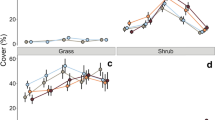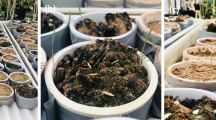Abstract
Biocrusts are key drivers of the structure and functioning of drylands and are very sensitive to disturbance, including atmospheric nitrogen (N) deposition. We studied the impacts of simulated N deposition on biocrust community composition and soil photosynthetic and photoprotective pigment content after five years of N application in a European semiarid Mediterranean shrubland. The experiment consisted in six experimental blocks with four plots, each receiving 0, 10, 20, or 50 kg NH4NO3-N ha−1 year−1 + 6–7 kg N ha−1 year−1 background. After 5 years of N application, total lichen cover decreased up to 50% compared to control conditions and these changes were only clearly evident when evaluated from a temporal perspective (i.e. as the percentage of change from the first survey in 2008 to the last survey in 2012). In contrast, moss cover did not change in response to N, suggesting that biocrust community alterations operate via species- and functional group-specific effects. Interestingly, between-year variations in biocrust cover tracked variations in autumnal precipitation, showing that these communities are more dynamic than previously thought. Biocrust species alterations in response to N were, however, often secondary when compared to the role of ecologically relevant drivers such as soil pH and shrub cover, which greatly determined the composition and inter-annual dynamics of the biocrust community. Similarly, cyanobacterial abundance and soil pigment concentration were greatly determined by biotic and abiotic interactions, soil pH for pigments, and organic matter content and shrub cover for cyanobacteria. Biocrusts, and particularly the lichen component, are highly sensitive to N deposition and their responses to pollutant N can be best understood when evaluated from a temporal and multivariate perspective, including impacts mediated by interactions with biotic and abiotic drivers.





Similar content being viewed by others
References
Arróniz-Crespo M, Leake JR, Horton P, Phoenix GK (2008) Bryophyte physiological responses to, and recovery from, long-term nitrogen deposition and phosphorus fertilisation in acidic grassland. New Phytol 180:864–874. https://doi.org/10.1111/j.1469-8137.2008.02617.x
Belnap J (2002) Impacts of off-road vehicles on nitrogen cycles in biological soil crusts: resistance in different U.S. deserts. J Arid Environ 52:155–165. https://doi.org/10.1006/jare.2002.0991
Belnap J, Phillips SL, Flint S et al (2008) Global change and biological soil crusts: effects of ultraviolet augmentation under altered precipitation regimes and nitrogen additions. Glob Chang Biol 14:670–686. https://doi.org/10.1111/j.1365-2486.2007.01509.x
Belnap J, Phillips SL, Troxler T (2006) Soil lichen and moss cover and species richness can be highly dynamic: the effects of invasion by the annual exotic grass Bromus tectorum, precipitation, and temperature on biological soil crusts in SE Utah. Appl Soil Ecol 32:63–76. https://doi.org/10.1016/j.apsoil.2004.12.010
Bobbink R, Hicks K, Galloway J et al (2010) Global assessment of nitrogen deposition effects on terrestrial plant diversity: a synthesis. Ecol Appl 20:30–59. https://doi.org/10.1890/08-1140.1
Bowker MA, Reed SC, Belnap J, Phillips SL (2002) Temporal variation in community composition, pigmentation, and Fv/Fm of desert cyanobacterial soil crusts. Microb Ecol 43:13–25. https://doi.org/10.1007/s00248-001-1013-9
Cabal C, Ochoa-Hueso R, Pérez-Corona ME, Manrique E (2017) Long-term simulated nitrogen deposition alters the plant cover dynamics of a Mediterranean rosemary shrubland in central Spain through defoliation. Environ Sci Pollut Res. https://doi.org/10.1007/s11356-017-8879-7
Castillo-Monroy AP, Maestre FT, Delgado-Baquerizo M, Gallardo A (2010) Biological soil crusts modulate nitrogen availability in semi-arid ecosystems: insights from a Mediterranean grassland. Plant Soil 333:21–34. https://doi.org/10.1007/s11104-009-0276-7
Concostrina-Zubiri L, Huber-Sannwald E, Martínez I et al (2013) Biological soil crusts greatly contribute to small-scale soil heterogeneity along a grazing gradient. Soil Biol Biochem 64:28–36. https://doi.org/10.1016/j.soilbio.2013.03.029
DeLuca TH, Zackrisson O, Gentili F et al (2007) Ecosystem controls on nitrogen fixation in boreal feather moss communities. Oecologia 152:121–130. https://doi.org/10.1007/s00442-006-0626-6
Duprè C, Stevens CJ, Ranke T et al (2010) Changes in species richness and composition in European acidic grasslands over the past 70 years: the contribution of cumulative atmospheric nitrogen deposition. Glob Chang Biol 16:344–357. https://doi.org/10.1111/j.1365-2486.2009.01982.x
Escolar C, Martínez I, Bowker MA, Maestre FT (2012) Warming reduces the growth and diversity of biological soil crusts in a semi-arid environment: implications for ecosystem structure and functioning. Philos Trans R Soc Lond Ser B Biol Sci 367:3087–3099. https://doi.org/10.1098/rstb.2011.0344
Fenn ME, Haeuber R, Tonnesen GS et al (2003) Nitrogen emissions, deposition, and monitoring in the Western United States. Bioscience 53:391–403. https://doi.org/10.1641/0006-3568(2003)053[0391:NEDAMI]2.0.CO;2
Fowler D, Coyle M, Skiba U et al (2013) The global nitrogen cycle in the twenty-first century. Philos Trans R Soc Lond Ser B Biol Sci 368:20130164. https://doi.org/10.1098/rstb.2013.0164
Fridley JD, Grime JP, Askew AP et al (2011) Soil heterogeneity buffers community response to climate change in species-rich grassland. Glob Chang Biol 17:2002–2011. https://doi.org/10.1111/j.1365-2486.2010.02347.x
Gordon C, Wynn JMM, Woodin SJJ (2002) Impacts of increased nitrogen supply on high Arctic heath: the importance of bryophytes and phosphorus availability. New Phytol 149:461–471. https://doi.org/10.1046/j.1469-8137.2001.00053.x
Gruber N, Galloway JN (2008) An earth-system perspective of the global nitrogen cycle. Nature 451:293–296. https://doi.org/10.1038/nature06592
Grundmann M, Schneider H, Russell SJ, Vogel JC (2006) Phylogenetic relationships of the moss genus Pleurochaete Lindb. (Bryales: Pottiaceae) based on chloroplast and nuclear genomic markers. Org Divers Evol 6:33–45. https://doi.org/10.1016/j.ode.2005.04.005
Gundale MJ, DeLuca TH, Nordin A (2011) Bryophytes attenuate anthropogenic nitrogen inputs in boreal forests. Glob Chang Biol 17:2743–2753. https://doi.org/10.1111/j.1365-2486.2011.02407.x
Horswill P, O’Sullivan O, Phoenix GK et al (2008) Base cation depletion, eutrophication and acidification of species-rich grasslands in response to long-term simulated nitrogen deposition. Environ Pollut 155:336–349. https://doi.org/10.1016/j.envpol.2007.11.006
Izquieta-Rojano S, Elustondo D, Ederra A et al (2016) Pleurochaete squarrosa (Brid.) Lindb. as an alternative moss species for biomonitoring surveys of heavy metal, nitrogen deposition and δ15N signatures in a Mediterranean area. Ecol Indic 60:1221–1228. https://doi.org/10.1016/j.ecolind.2015.09.023
Jimenez Aguilar A, Huber-Sannwald E, Belnap J et al (2009) Biological soil crusts exhibit a dynamic response to seasonal rain and release from grazing with implications for soil stability. J Arid Environ 73:1158–1169. https://doi.org/10.1016/j.jaridenv.2009.05.009
Johansson O, Palmqvist K, Olofsson J (2012) Nitrogen deposition drives lichen community changes through differential species responses. Glob Chang Biol 18:2626–2635. https://doi.org/10.1111/j.1365-2486.2012.02723.x
Lü X-T, Wei C-Z, Cui Q et al (2010) Interactive effects of soil nitrogen and water availability on leaf mass loss in a temperate steppe. Plant Soil 331:497–504. https://doi.org/10.1007/s11104-009-0270-0
Maestre FT, Bowker MA, Cantón Y et al (2011) Ecology and functional roles of biological soil crusts in semi-arid ecosystems of Spain. J Arid Environ 75:1282–1291. https://doi.org/10.1016/j.jaridenv.2010.12.008
Ochoa-Hueso R (2017) Consecuencias de la deposición de nitrógeno sobre la biodiversidad y el funcionamiento de los ecosistemas terrestres: Una aproximación general desde la ecología de ecosistemas. Ecosistemas 26:25-36. https://doi.org/10.7818/ECOS.2017.26-1.05
Ochoa-Hueso R, Arróniz-Crespo M, Bowker MA et al (2014) Biogeochemical indicators of elevated nitrogen deposition in semiarid Mediterranean ecosystems. Environ Monit Assess 186:5831–5842. https://doi.org/10.1007/s10661-014-3822-6
Ochoa-Hueso R, Delgado-Baquerizo M, Gallardo A et al (2016) Climatic conditions, soil fertility and atmospheric nitrogen deposition largely determine the structure and functioning of microbial communities in biocrust-dominated Mediterranean drylands. Plant Soil 399:271–282. https://doi.org/10.1007/s11104-015-2695-y
Ochoa-Hueso R, Hernandez RR, Pueyo JJ, Manrique E (2011) Spatial distribution and physiology of biological soil crusts from semi-arid central Spain are related to soil chemistry and shrub cover. Soil Biol Biochem 43:1894–1901. https://doi.org/10.1016/j.soilbio.2011.05.010
Ochoa-Hueso R, Manrique E (2011) Effects of nitrogen deposition and soil fertility on cover and physiology of Cladonia foliacea (Huds.) Willd., a lichen of biological soil crusts from Mediterranean Spain. Environ Pollut 159:449–457. https://doi.org/10.1016/j.envpol.2010.10.021
Ochoa-Hueso R, Manrique E (2013) Effects of nitrogen deposition on growth and physiology of Pleurochaete squarrosa (Brid.) Lindb., a terricolous moss from Mediterranean ecosystems. Water Air Soil Pollut 224:1492. https://doi.org/10.1007/s11270-013-1492-6
Ochoa-Hueso R, Manrique E (2014) Impacts of altered precipitation, nitrogen deposition and plant competition on a Mediterranean seed bank. J Veg Sci 25:1289–1298. https://doi.org/10.1111/jvs.12183
Ochoa-Hueso R, Mejías-Sanz V, Pérez-Corona ME, Manrique E (2013a) Nitrogen deposition effects on tissue chemistry and phosphatase activity in Cladonia foliacea (Huds.) Willd., a common terricolous lichen of semi-arid Mediterranean shrublands. J Arid Environ 88:78–81. https://doi.org/10.1016/j.jaridenv.2012.07.007
Ochoa-Hueso R, Munzi S, Alonso R et al (2017) Ecological impacts of atmospheric pollution and interactions with climate change in terrestrial ecosystems of the Mediterranean Basin: current research and future directions. Environ Pollut 227:194–206. https://doi.org/10.1016/j.envpol.2017.04.062
Ochoa-Hueso R, Stevens CJ, Ortiz-Llorente MJ, Manrique E (2013b) Soil chemistry and fertility alterations in response to N application in a semiarid Mediterranean shrubland. Sci Total Environ 452–453:78–86. https://doi.org/10.1016/j.scitotenv.2013.02.049
Pearce ISK, Woodin SJ, Van Der Wal R (2003) Physiological and growth responses of the montane bryophyte Racomitrium lanuginosum to atmospheric nitrogen deposition. New Phytol 160:145–155. https://doi.org/10.1046/j.1469-8137.2003.00875.x
Phoenix GK, Hicks WK, Cinderby S et al (2006) Atmospheric nitrogen deposition in world biodiversity hotspots: the need for a greater global perspective in assessing N deposition impacts. Glob Chang Biol 12:470–476. https://doi.org/10.1111/j.1365-2486.2006.01104.x
Pinho P, Dias T, Cruz C et al (2011) Using lichen functional diversity to assess the effects of atmospheric ammonia in Mediterranean woodlands. J Appl Ecol 48:1107–1116. https://doi.org/10.1111/j.1365-2664.2011.02033.x
R Core Team (2017) R: a language and environment for statistical computing. R Foundation for Statistical Computing, Vienna
Reed SC, Maestre FT, Ochoa-Hueso R et al (2016) Biocrusts in the context of global change. In: Weber B (ed) Biological soil crusts: an organizing principle in drylands. Springer, Cham, pp 451–476
Rodríguez-Caballero E, Cantón Y, Chamizo S et al (2012) Effects of biological soil crusts on surface roughness and implications for runoff and erosion. Geomorphology 145–146:81–89. https://doi.org/10.1016/j.geomorph.2011.12.042
Ros RM, Mazimpaka V, Abou-Salama U et al (2013) Mosses of the Mediterranean, an annotated checklist. Cryptogam Bryol 34:99–283. https://doi.org/10.7872/cryb.v34.iss2.2013.99
Sala OE, Chapin FS, Armesto JJ et al (2000) Global biodiversity scenarios for the year 2100. Science 287:1770–1774. https://doi.org/10.1126/science.287.5459.1770
Stevens CJ, Dise NB, Mountford JO, Gowing DJ (2004) Impact of nitrogen deposition on the species richness of grasslands. Science 303:1876–1879. https://doi.org/10.1126/science.1094678
Stevens CJ, Duprè C, Dorland E et al (2010) Nitrogen deposition threatens species richness of grasslands across Europe. Environ Pollut 158:2940–2945. https://doi.org/10.1016/j.envpol.2010.06.006
Turetsky MR (2003) The role of bryophytes in carbon and nitrogen cycling. Bryologist 106:395–409. https://doi.org/10.1639/05
Val J, Monge E, Baker NR (1994) An improved HPLC method for rapid analysis of the xanthophylls cycle pigments. J Chromatogr Sci 32:286–289. https://doi.org/10.1093/chromsci/32.7.286
Vourlitis GL, Pasquini SC, Mustard R (2009) Effects of dry-season N input on the productivity and N storage of Mediterranean-type shrublands. Ecosystems 12:473–488. https://doi.org/10.1007/s10021-009-9236-6
Waldrop MP, Zak DR (2006) Response of oxidative enzyme activities to nitrogen deposition affects soil concentrations of dissolved organic carbon. Ecosystems 9:921–933. https://doi.org/10.1007/s10021-004-0149-0
Werner O, Ros RM, Grundmann M (2005) Molecular phylogeny of Trichostomoideae (Pottiaceae, Bryophyta) based on nrITS sequence data. Taxon 54:361–368. https://doi.org/10.2307/25065364
Author information
Authors and Affiliations
Corresponding author
Additional information
Responsible editor: Philippe Garrigues
Rights and permissions
About this article
Cite this article
Ochoa-Hueso, R., Mondragon-Cortés, T., Concostrina-Zubiri, L. et al. Nitrogen deposition reduces the cover of biocrust-forming lichens and soil pigment content in a semiarid Mediterranean shrubland. Environ Sci Pollut Res 24, 26172–26184 (2017). https://doi.org/10.1007/s11356-017-0482-4
Received:
Accepted:
Published:
Issue Date:
DOI: https://doi.org/10.1007/s11356-017-0482-4




